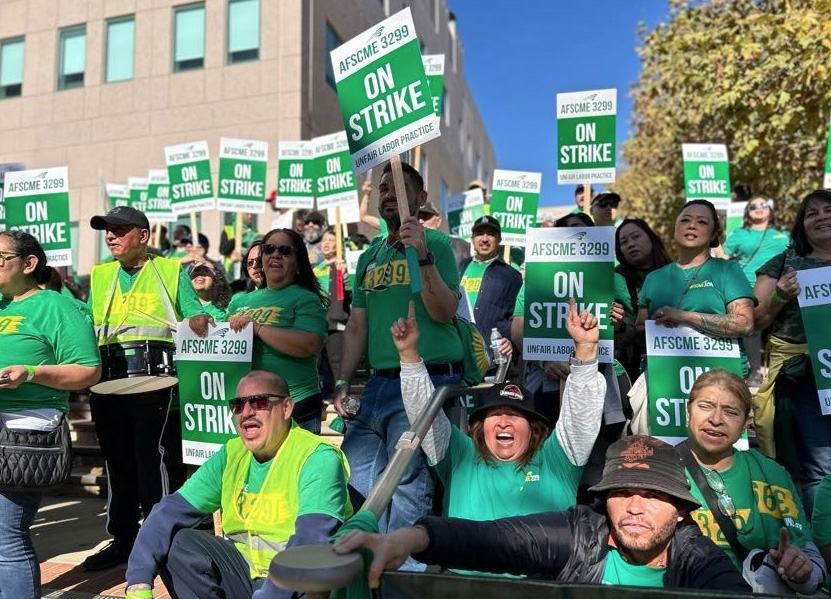Two Portland, Oregon unions representing city employees are getting closer to walking off the job over a breakdown in contract negotiations.
The American Federation of State, County and Municipal Employees Local 189, represents more than 1,000 workers across nearly every city department.
The District Council of Trade Unions represents 200 engineers, painters, plumbers and electricians.
Both unions, who have been negotiating new contacts with the city since last April, have reached an impasse with city management over wages.
The city, which is facing a $100 million budget deficit, says its limited finances are the ‘biggest obstacle’ in contract negotiations.
Without the two sides reaching an agreement, the unions are prepared to strike.
Starting yesterday, AFSCME members are to vote on whether or not to authorise a strike.
Voting will last five days.
If the union votes in favour, union leaders are expected to give the city a mandatory 10-day strike notice.
That means workers could walk off the job before the end of February.
But DCTU could beat them to it.
DCTU members voted earlier this month to authorise a strike.
The DCTU could strike as soon as the first week of February.
Portland City Council tried to cool labour tensions last Wednesday, by unanimously voting to withdraw a prior labour complaint filed against AFSCME.
The city human resources managers and lawyers – not elected officials – are the city’s representatives in labour negotiations.
Meanwhile, interest in union organising is surging in the United States.
Since 2021, petitions for union elections at the National Labour Relations Board (NLRB) have doubled, the US think tank, the Economic Policy Institute (EPI), said in a report released on Tuesday.
Public support for unions is near a 60-year high – at 70 per cent.
This growing momentum around union organising signals a powerful push by workers to improve wages, working conditions, and workplace rights.
The EPI research shows that 60 million workers would join a union if they could.
Decades of attacks on unions both on federal and state levels have made it hard for workers to form and maintain unions in some places, but workers are determined to be represented.
Further, weaknesses in federal labour law have made it possible for employers to oppose unions, contributing to this decline.
In this report, we examine the 2024 Bureau of Labour Statistics (BLS) data on unionisation and highlight recent organising campaigns.
We analyse the obstacles workers face when forming unions and reaching a first contract.
Finally, we offer policy recommendations to promote unionisation and generate an economy that works for all.
In 2024, 16 million workers in the United States were represented by a union.
This was 11.1 per cent of all wage and salary workers.
Unionisation is higher in the public sector than the private sector, but numbers of workers in the private sector have grown significantly in the last year.
In 2024, 35.7 per cent of public sector workers were covered by a union contract, compared with 6.7 per cent of private sector workers.
The unionisation rate among federal government workers rose by 0.9 percentage points.
Within the private sector, there was a particularly large movement in private education and health services, which saw a net increase of 70,000.
The unionisation of black, Asian and Hispanic workers provides a useful reminder that the conventional idea of union members being largely white men is out of date.
Out of all the major racial and ethnic groups, Black workers continued to have the highest unionisation rates in 2024, at 13.2 per cent.
The 13.2 per cent unionisation rate for Black workers compares with 10.8 per cent for white workers, 9.8 per cent for Asian workers, and 9.7 per cent for Hispanic workers.
Workers of colour, taken together, saw an increase in unionisation levels of 68,000 in 2024, the largest amongst all sections of workers
- On Monday, workers at a Philadelphia Whole Foods Market voted to join United Food and Commercial Workers (UFCW) Local 1776, making them the first union store in Amazon’s grocery chain.
The e-commerce giant has owned Whole Foods since 2017.
Since taking over, Amazon has rolled back numerous worker benefits, cut staffing and changed things like attendance policies for the worse.
As expected, this campaign was faced with numerous instances of anti-union retaliation and intimidation tactics, forcing UFCW to file unfair labour practice charges against the grocer.
Full and part-time staff cite the need for livable wages, affordable health care and better retirement packages as key motivators for organising.
But members of Whole Foods Workers United also hope their story of taking on a union-busting behemoth – and winning – will also inspire their counterparts at hundreds of locations across the country.
Ben Lovett, a member of Whole Foods Workers United said: ‘I expect others to follow, and that will increase the leverage that we have at the bargaining table.
‘We’ve shown them that it’s possible to organise at Amazon.’
Wendell Young, president of Local 1776 said: ‘This fight is far from over, but today’s victory is an important step forward.
‘We are ready to bring Whole Foods to the bargaining table to negotiate a fair first contract that reflects the workers’ needs and priorities.’
UFCW International President Marc Perrone said: ‘Today, we celebrate an incredible victory for the workers at Whole Foods in Philadelphia who have stood together to secure the union representation they deserve.
‘This win sends a powerful message to workers everywhere that when we stand together, we can take on even the largest corporations and win.’
Whole Foods and its parent company, Amazon, have long resisted unionisation efforts, but this election shows that workers’ determination and unity can triumph.
